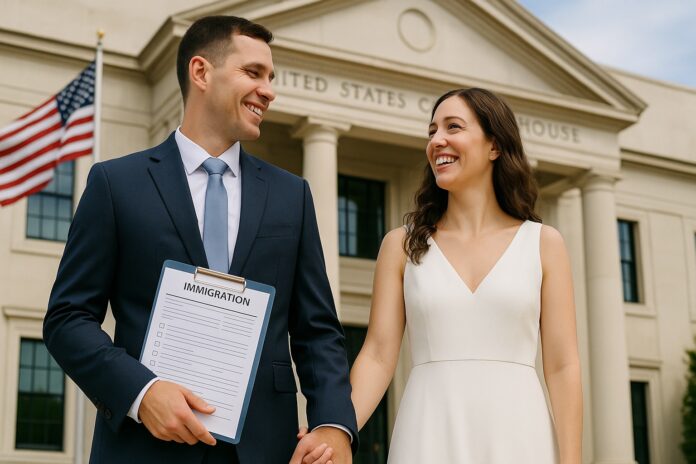What Happens After Your K-1 Fiancé(e) Visa Is Approved? Complete 2025 Guide
Congratulations! If your K-1 Fiancé(e) Visa has been approved, you’ve reached a major milestone in your immigration journey. Many couples breathe a sigh of relief at this stage, but approval is not the end — it’s the beginning.
The K-1 Visa is designed to allow foreign nationals engaged to U.S. citizens to enter the United States and marry within 90 days. After approval, there are still critical steps you must take, and missing any of them can cause serious immigration problems.
This guide explains exactly what happens after your K-1 Visa is approved, including travel rules, the marriage deadline, Adjustment of Status, work and travel permits, and the path to a Green Card and citizenship.
📦 1. Receiving Your K-1 Visa Packet
After approval at your embassy or consulate, you’ll receive:
- Your passport with the K-1 Visa stamp
- A sealed visa packet with your case documents
⚠️ Do not open the packet. Only U.S. Customs and Border Protection (CBP) officials can open it at the airport.
The K-1 Visa is usually valid for 6 months. You must travel to the U.S. within this period.
💡 Tip: Check your visa stamp carefully for errors (name, birthdate, expiration). If something is wrong, contact the embassy right away.
✈️ 2. Traveling to the U.S.
At the port of entry in the U.S.:
- Present your passport and sealed visa packet
- CBP will review your documents and may ask basic questions about your fiancé(e)
- If all is correct, you’ll be admitted under K-1 nonimmigrant status
You’ll normally be admitted for 90 days, which is your marriage window.
⚠️ You cannot use the K-1 Visa after its expiration date.
💡 Travel tip: Carry copies of your engagement proof and your fiancé(e)’s contact info in case CBP asks for more details.
💍 3. The 90-Day Marriage Requirement
The most important rule: you must marry your U.S. citizen fiancé(e) within 90 days of entry.
✅ Valid Marriage
- Must be legally recognized by the state where you marry
- Religious or cultural ceremonies alone are not enough unless legally registered
❌ If You Don’t Marry
- Your visa expires and you fall out of status
- You must leave the U.S.
- Staying past 90 days may cause deportation and bans
- You cannot switch to another visa
💡 Tip: If you want a big wedding later, have a courthouse marriage first to meet immigration rules.
📝 4. Filing for Adjustment of Status (Green Card)
Once married, you must apply for a Green Card through Adjustment of Status (AOS).
Forms to File:
- I-485 – Application to Adjust Status
- I-864 – Affidavit of Support (from U.S. spouse)
- I-765 – Work Permit application (optional)
- I-131 – Travel Permit application (optional)
Process:
- File all forms with supporting evidence (marriage certificate, photos, joint bank accounts, etc.)
- Attend biometrics appointment
- Wait for USCIS processing (8–14 months in 2025)
- Attend interview with your spouse
If approved:
- Married less than 2 years → you receive a 2-year Conditional Green Card
- Married more than 2 years → you receive a 10-year Permanent Green Card
💡 Tip: Start collecting evidence of a real marriage (leases, insurance, utility bills) early.
💼 5. Work and Travel While Waiting
You cannot work immediately on a K-1 Visa.
- File Form I-765 for a Work Permit (3–6 months processing)
- File Form I-131 for Advance Parole if you want to travel outside the U.S.
⚠️ Leaving without Advance Parole cancels your application.
💡 Best practice: File I-485 + I-765 + I-131 together to save time.
❌ 6. If the Marriage Doesn’t Happen
If you don’t marry within 90 days:
- Your visa expires → you’re out of status
- You cannot stay in the U.S. legally
- You must leave the country immediately
- Overstaying may trigger 3-year or 10-year reentry bans
💡 Example:
- 180+ days overstay → 3-year ban
- 1+ year overstay → 10-year ban
🛤️ 7. Life After Marriage – Green Card Journey
After AOS approval:
- You’ll get a 2-year Conditional Green Card
- Before it expires, file Form I-751 with your spouse to remove conditions
- After 3 years with a U.S. citizen spouse, you may apply for citizenship (Form N-400)
Benefits of Green Card status:
- Live and work permanently in the U.S.
- Eligible for certain benefits
- Pathway to U.S. citizenship
⚠️ 8. Common Mistakes to Avoid
- Forgetting the 90-day deadline
- Delaying AOS filing
- Working without a permit
- Traveling without Advance Parole
- Not saving marriage evidence for USCIS
You’ll need to apply for work authorization — learn how to work on a K-1 Visa.
If you’re bringing children, check the K-2 Visa guide.
✅ Conclusion
Approval of your K-1 Visa is an exciting step — but it’s just the start. To build a secure future in the U.S., you must:
- Enter the U.S. within 6 months of visa issuance
- Marry your fiancé(e) within 90 days
- File for Adjustment of Status quickly
- Apply for work/travel permits if needed
- Avoid mistakes that could jeopardize your case
Handled correctly, the K-1 Visa leads to a Green Card and eventually U.S. citizenship. With careful planning — and professional guidance if needed — you and your fiancé(e) can start your new life together with confidence.


